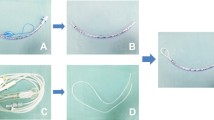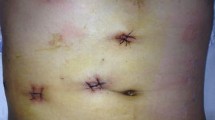Abstract
Background
A primary concern during laparoscopic liver resection (lapLR) is hemorrhage during parenchymal transection. Intermittent pedicle clamping is an effective method to minimize blood loss during open liver surgery; however, inflow occlusion techniques are challenging to reproduce during laparoscopy. The purpose of this study is to describe the safety and efficacy of a facile method for Pringle maneuver during lapLR.
Methods
154 patients who underwent lapLR from 2007 to 2013 were retrospectively reviewed. For Pringle, the hepatoduodenal ligament is encircled with an umbilical tape which is externalized through a flexible Rumel tourniquet running alongside a port used for the operation. The internal end of the catheter is close to the pedicle and the external end is extracorporeal, allowing for easy external occlusion. Patients who underwent Pringle Maneuver (PM, n = 88) were compared to patients who had “No Occlusion” (NO, n = 66) with respect to patient characteristics, operative outcomes, changes in postoperative liver function, and complications.
Results
Annual placement of the tourniquet and vascular occlusion increased from 35.7 to 82.8 % (p = 0.004) and 21.4 to 62.1 % (p = 0.02), respectively. Median occlusion time was 24 min (IQR 15–34.3, min 5, max 70). Peak transaminase levels were comparable between groups (AST 298 ± 32 vs 405 ± 47 U/L, p = 0.15; ALT 272 ± 27 vs 372 ± 34 U/L, p = 0.14, NO and PM, respectively). Postoperative transaminase and bilirubin levels for both groups were not significantly different with similar recovery to baseline. Subgroup analysis of cirrhotic patients who underwent Pringle demonstrated similar transaminase profiles compared to non-cirrhotic patients. There were two conversions (1.3 %) and postoperative 30-day mortality was 0.65 %.
Conclusion
Extracorporeal tourniquet placement in lapLR is a quick and safe method of gaining control for inflow occlusion. Routine adoption of laparoscopic Pringle maneuver facilitates low conversion rates without liver injury.



Similar content being viewed by others
References
Buell JF, Thomas MT, Rudich S, Marvin M, Nagubandi R, Ravindra KV, Brock G, McMasters KM (2008) Experience with more than 500 minimally invasive hepatic procedures. Ann Surg 248:475–486
Reddy SK, Tsung A, Geller DA (2011) Laparoscopic liver resection. World J Surg 35:1478–1486
Vigano L, Tayar C, Laurent A, Cherqui D (2009) Laparoscopic liver resection: a systematic review. J Hepatobiliary Pancreat Surg 16:410–421
Kooby DA, Stockman J, Ben-Porat L, Gonen M, Jarnagin WR, Dematteo RP, Tuorto S, Wuest D, Blumgart LH, Fong Y (2003) Influence of transfusions on perioperative and long-term outcome in patients following hepatic resection for colorectal metastases. Ann Surg 237:860–869; discussion 869–870
Shiba H, Ishida Y, Wakiyama S, Iida T, Matsumoto M, Sakamoto T, Ito R, Gocho T, Furukawa K, Fujiwara Y, Hirohara S, Misawa T, Yanaga K (2009) Negative impact of blood transfusion on recurrence and prognosis of hepatocellular carcinoma after hepatic resection. J Gastrointest Surg 13:1636–1642
Lesurtel M, Lehmann K, de Rougemont O, Clavien PA (2009) Clamping techniques and protecting strategies in liver surgery. HPB (Oxford) 11:290–295
Maehara S, Adachi E, Shimada M, Taketomi A, Shirabe K, Tanaka S, Maeda T, Ikeda K, Higashi H, Maehara Y (2007) Clinical usefulness of biliary scope for Pringle’s maneuver in laparoscopic hepatectomy. J Am Coll Surg 205:816–818
Cho A, Yamamoto H, Nagata M, Takiguchi N, Shimada H, Kainuma O, Souda H, Gunji H, Miyazaki A, Ikeda A (2010) Safe and feasible inflow occlusion in laparoscopic liver resection. Surg Endosc 24:246
Belli G, Fantini C, D’Agostino A, Cioffi L, Limongelli P, Russo G, Belli A (2008) Laparoscopic segment VI liver resection using a left lateral decubitus position: a personal modified technique. J Gastrointest Surg 12:2221–2226
Abu Hilal M, Underwood T, Taylor MG, Hamdan K, Elberm H, Pearce NW (2010) Bleeding and hemostasis in laparoscopic liver surgery. Surg Endosc 24:572–577
Bryant R, Laurent A, Tayar C, Cherqui D (2009) Laparoscopic liver resection-understanding its role in current practice: the Henri Mondor Hospital experience. Ann Surg 250:103–111
Chouillard EK, Gumbs AA, Cherqui D (2010) Vascular clamping in liver surgery: physiology, indications and techniques. Ann Surg Innov Res 4:2
Cherqui D, Husson E, Hammoud R, Malassagne B, Stephan F, Bensaid S, Rotman N, Fagniez PL (2000) Laparoscopic liver resections: a feasibility study in 30 patients. Ann Surg 232:753–762
Komeda K, Hayashi M, Inoue Y, Shimizu T, Asakuma M, Hirokawa F, Miyamoto Y, Uchiyama K (2013) Clinical usefulness of endo intestinal clips during Pringle’s maneuver in laparoscopic liver resection: a technical report. Surg Laparosc Endosc Percutan Tech 23:e103–e105
Decailliot F, Streich B, Heurtematte Y, Duvaldestin P, Cherqui D, Stephan F (2005) Hemodynamic effects of portal triad clamping with and without pneumoperitoneum: an echocardiographic study. Anesth Analg 100:617–622; table of contents
Sugiyama Y, Ishizaki Y, Imamura H, Sugo H, Yoshimoto J, Kawasaki S (2010) Effects of intermittent Pringle’s manoeuvre on cirrhotic compared with normal liver. Br J Surg 97:1062–1069
Balzan S, Belghiti J, Farges O, Ogata S, Sauvanet A, Delefosse D, Durand F (2005) The “50-50 criteria” on postoperative day 5: an accurate predictor of liver failure and death after hepatectomy. Ann Surg 242:824–828; discussion 828–829
Zhen ZJ, Lau WY, Wang FJ, Lai EC (2010) Laparoscopic liver resection for hepatocellular carcinoma in the left liver: Pringle maneuver versus tourniquet method. World J Surg 34:314–319
Okuda Y, Honda G, Kurata M, Kobayashi S (2013) Useful and convenient procedure for intermittent vascular occlusion in laparoscopic hepatectomy. Asian J Endosc Surg 6:100–103
Patriti A, Ceribelli C, Ceccarelli G, Bartoli A, Bellochi R, Casciola L (2012) Non-cirrhotic liver tolerance to intermittent inflow occlusion during laparoscopic liver resection. Updates Surg 64:87–93
Disclosures
Monica M. Dua, David J. Worhunsky, Kimberly Hwa, George A. Poultsides, Jeffrey A. Norton, and Brendan C. Visser have no conflicts of interest or financial support to disclosure.
Author information
Authors and Affiliations
Corresponding author
Rights and permissions
About this article
Cite this article
Dua, M.M., Worhunsky, D.J., Hwa, K. et al. Extracorporeal Pringle for laparoscopic liver resection. Surg Endosc 29, 1348–1355 (2015). https://doi.org/10.1007/s00464-014-3801-6
Received:
Accepted:
Published:
Issue Date:
DOI: https://doi.org/10.1007/s00464-014-3801-6




